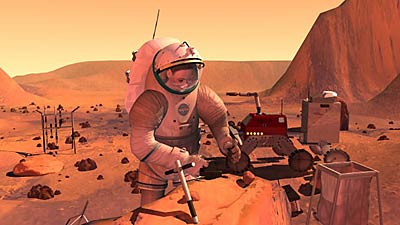Ten years back, ten years forwardby Louis Friedman
|
| Will human spaceflight be mundane, or will it be inspiring, extending the human reach further to new worlds with new accomplishments for a new generation? |
I am concerned about space exploration, a uniquely government activity that rises to the highest level of public interest out of a sea of many other diverse activities in space. The diverse activities of technology development, environmental and weather monitoring, communications, defense, tourism, commercial entrepreneurship, education, and training involve much more than NASA, but the course of space exploration will be set strictly by NASA.
NASA’s human program will continue, and it will continue to be the big budget item of NASA. No president is going to say that America’s time in space has come and gone and now it is the turn of other nations (at least not in the next ten years). NASA and the industry need not be concerned about government support for aerospace spending on human space exploration: they will get it with or without a mission. The only question is for what? Will human spaceflight be mundane (confined to Earth orbit with high activity but no overriding purpose) or will it be inspiring, extending the human reach further to new worlds with new accomplishments for a new generation? We are on the cusp of making that decision.
We had a similar decision to make in 1970 after the Apollo achievement. Then we (more precisely, the Nixon Administration) chose to turn inward to stay in Earth orbit repetitively. That decision defined a shrinking NASA for four decades. Now, after the Shuttle/Space Station program we have the same kind of choice: to do more of the same with the almost certain result of shrinking public interest further, or do something new, engaging a new generation with American leadership and accomplishments deeper into space.
| I describe this as the great space race: between robots and humans. Not a race of funding or destination but instead a race for the hearts and mind of people. |
The Obama Administration acceptance of the recommendations from 2009 Human Space Flight Plans Committee (aka Augustine Committee) bodes well. The recommendations set the nation on a humans-to-Mars path while realistically recognizing the need for step-by-step interim accomplishments. They defined a flexible path to be traversed at a pace dictated by budget constraints. The plan and path are good, but the failure to inspire the public with it imperils its sustainability. That failure is due in part to congressional meddling with rocket construction and aerospace community special interests, and in part from the administration’s own bureaucratic inhibitions. If the path isn’t sustained, and if we don’t boldly put humans on it to go into the solar system, then the whole role of humans in space will be questioned—not just politically, but publicly.
I describe this as the great space race: between robots and humans. Not a race of funding or destination (those can and should be synergistic) but instead a race for the hearts and mind of people. Thus far in the space age, public inspiration has been dominated by the human flight adventure. But a new generation of popular interest finds virtual worlds and robotic adventures also inspiring. If human flight remains mundane, robotic adventure and discoveries at other worlds will pass it by. I am human—I am rooting for the humans not to stay hidebound in the Earth’s gravity well while robots go further, faster, longer.
In the long run—interstellar-type long runs—I believe that will happen. Robotic technology is and will grow faster that human life support technology. But, surely we can get beyond the Moon, step on asteroids, fly to and around Mars, then land and settle on it before we question our human limits. The inspiration of pushing our human limits to another world will sustain us for decades if we really are pushing. That’s our challenge for the next 10 years: to inspire.
